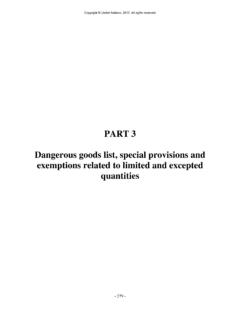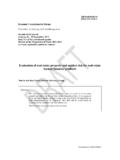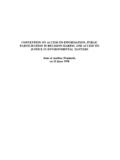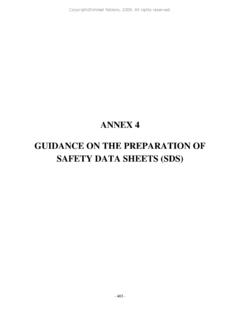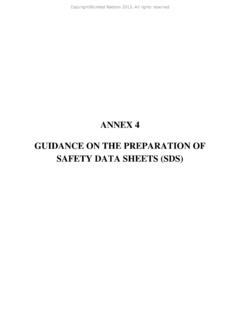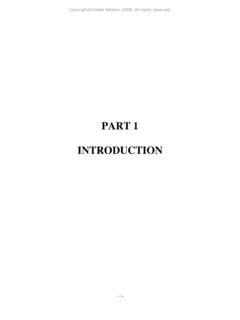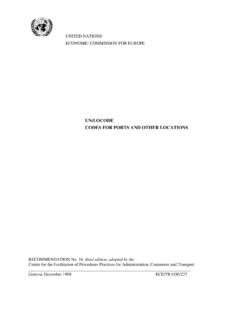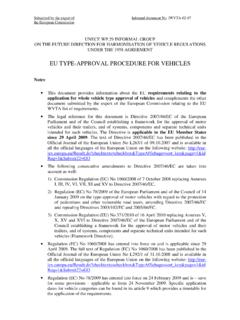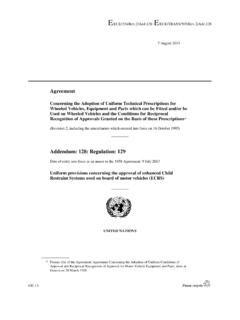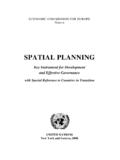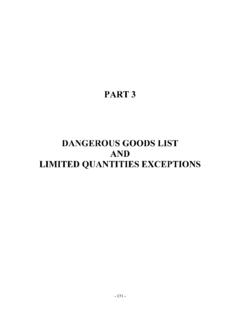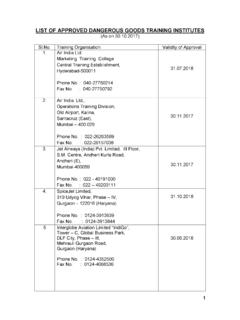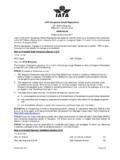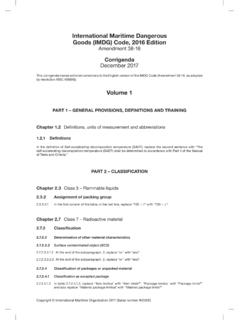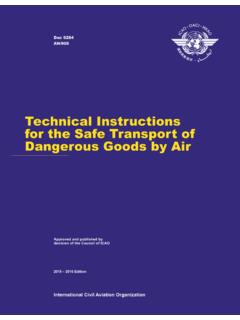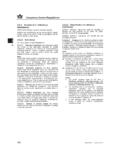Transcription of PART 3 DANGEROUS GOODS LIST AND LIMITED ... - UNECE …
1 - 145 - PART 3 DANGEROUS GOODS LIST AND LIMITED QUANTITIES EXCEPTIONS - 147 - CHAPTER GENERAL Scope and general provisions The DANGEROUS GOODS List in this Chapter lists the DANGEROUS GOODS most commonly carried but is not exhaustive. It is intended that the list cover, as far as practicable, all DANGEROUS substances of commercial importance. Where a substance or article is specifically listed by name in the DANGEROUS GOODS List, it shall be transported in accordance with the provisions in the List which are appropriate for that substance or article.
2 A "generic" or "not otherwise specified" entry may be used to permit the transport of substances or articles which do not appear specifically by name in the DANGEROUS GOODS List. Such a substance or article may be transported only after its DANGEROUS properties have been determined. The substance or article shall then be classified according to the class definitions and test criteria and the name in the DANGEROUS GOODS List which most appropriately describes the substance or article shall be used.
3 The classification shall be made by the appropriate competent authority when so required or may otherwise be made by the consignor. Once the class of the substance or article has been so established, all conditions for dispatch and transport, as provided in these Regulations shall be met. Any substance or article having or suspected of having explosive characteristics shall first be considered for inclusion in Class 1. Some collective entries may be of the "generic" or "not otherwise specified" type provided that the regulations contain provisions ensuring safety, both by excluding extremely DANGEROUS GOODS from normal transport and by covering all subsidiary risks inherent in some GOODS .
4 The DANGEROUS GOODS List does not include GOODS which are so DANGEROUS that their transport, except with special authorization, is prohibited. Such GOODS are not listed because the transport of some GOODS may be prohibited for some modes of transport and allowed in others and, in addition, because it would be impossible to draw up an exhaustive list. Moreover, any such list would soon cease to be exhaustive because of the frequent introduction of new substances; and the absence of a substance from such a list might give the mistaken impression that that substance could be carried without special restrictions.
5 Inherent instability in GOODS may take different DANGEROUS forms, for example, explosion, polymerization, with intense evolution of heat, or emission of toxic gases. In respect of most substances, such tendencies can be controlled by correct packing, dilution, stabilization, addition of an inhibitor, refrigeration or other precautions. Where precautionary measures are laid down in the DANGEROUS GOODS List in respect of a given substance or article ( that it shall be "stabilized" or "with x% water or phlegmatizer") such substance or article may not normally be carried when these measures have not been taken, unless the item in question is listed elsewhere ( Class 1) without any indication of, or with different, precautionary measures.
6 Proper shipping name NOTE 1: For proper shipping names to be used for DANGEROUS GOODS transported as LIMITED quantities, see NOTE 2: For proper shipping names used for the transport of samples, see - 148 - The proper shipping name is that portion of the entry most accurately describing the GOODS in the DANGEROUS GOODS List, which is shown in upper case characters (plus any numbers, Greek letters, 'sec', 'tert', and the letters m, n, o, p, which form an integral part of the name).
7 An alternative proper shipping name may be shown in brackets following the main proper shipping name [ , ETHANOL (ETHYL ALCOHOL)]. Portions of an entry appearing in lower case need not be considered as part of the proper shipping name but may be used. When conjunctions such as "and" or "or" are in lower case or when segments of the name are punctuated by commas, the entire name of the entry need not necessarily be shown in the transport document or package markings.
8 This is the case particularly when a combination of several distinct entries are listed under a single UN Number. Examples illustrating the selection of the proper shipping name for such entries are: (a) UN 1057 LIGHTERS or LIGHTER REFILLS - The proper shipping name is the most appropriate of the following possible combinations: LIGHTERS LIGHTER REFILLS.
9 (b) UN 3207 ORGANOMETALLIC COMPOUND or COMPOUND SOLUTION or COMPOUND DISPERSION, WATER-REACTIVE, FLAMMABLE, *. The proper shipping name is the most appropriate of the following possible combinations: ORGANOMETALLIC COMPOUND, WATER-REACTIVE, FLAMMABLE, ORGANOMETALLIC COMPOUND SOLUTION, WATER-REACTIVE, FLAMMABLE, ORGANOMETALLIC COMPOUND DISPERSION, WATER-REACTIVE, FLAMMABLE, each supplemented with the technical name of the GOODS (see ).
10 Proper shipping names may be used in the singular or plural as appropriate. In addition, when qualifying words are used as part of the proper shipping name, their sequence on documentation or package markings is optional. For instance, "DIMETHYLAMINE AQUEOUS SOLUTION" may alternatively be shown "AQUEOUS SOLUTION OF DIMETHYLAMINE". Commercial or military names for GOODS of Class 1 which contain the proper shipping name supplemented by additional descriptive text may be used.
